

Raising_Students. Helping Early Literacy with Practice Strategies. Educators and researchers generally agree that the essential components of early elementary reading instruction should target phonics, phonemic awareness, fluency, comprehension, and vocabulary.
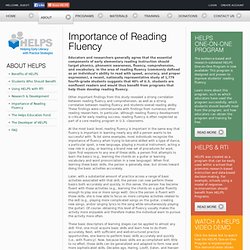
In the area of reading fluency (commonly defined as an individual's ability to read with speed, accuracy, and proper expression), a recent, nationally representative study of 1,779 fourth-grade students suggests that 40% of U.S. students are nonfluent readers and would thus benefit from programs that help them develop reading fluency.
Other important findings from this study revealed a strong correlation between reading fluency and comprehension, as well as a strong correlation between reading fluency and students overall reading ability. These findings were commensurate with findings from numerous other reading researchers. At the most basic level, reading fluency is important in the same way that fluency is important in learning nearly any skill a person wants to be successful with. Why is Fluency Relevant to My Teaching Expertise? Why is Motivating Students to Read Relevant to My Teaching Expertise? READ 7262, article 1. READ 7262, article 1 critique, for presentation uploading.
READ 7262, article 2. READ 7262, article 2 critique, for presentation uploading. READ 7262, article 3. READ 7262, article 3 critique, for presentation uploading. 5 Surefire Strategies for Developing Reading Fluency. Have you ever watched students struggle with what you know to be a great book, just perfect for their age and development?
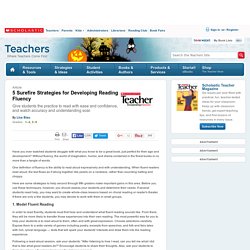
Without fluency, the world of imagination, humor, and drama contained in the finest books is no more than a tangle of words. One definition of fluency is the ability to read aloud expressively and with understanding. When fluent readers read aloud, the text flows as if strung together like pearls on a necklace, rather than sounding halting and choppy. Here are some strategies to help second through fifth graders make important gains in this area.
Technologytoimprovereading. Teaching fluency on Pinterest. Prtutor_lesson3.pdf. iOS App for iPhone, iPad, and iPod Touch. 50 Popular iPad Apps For Struggling Readers & Writers. Whether you’re the parent of a child with a reading disability or an educator that works with learning disabled students on a daily basis, you’re undoubtedly always looking for new tools to help these bright young kids meet their potential and work through their disability.
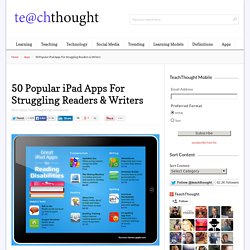
While there are numerous technologies out there that can help, perhaps one of the richest is the iPad, which offers dozens of applications designed to meet the needs of learning disabled kids and beginning readers alike. Strategies_to_Motivate_Struggling_Readers. 25 Ideas to Motivate Young Readers. The folks at the BOOK-IT!

Program have given permission for Education World to reprint 25 great ideas from teachers -- ideas that are sure to get kids across the grades excited about reading. The BOOK IT! Reading Incentive Program, sponsored by Pizza Hut, has motivated millions of young readers over the years. Note: The following teacher ideas were originally published by the BOOK IT! National Reading Incentive Program. Motivating-and-engaging-students-in-reading-Cambria-Guthrie. 16 Apps That Motivate Kids to Read. For every kid who is caught hiding beneath his covers with a flashlight and a novel at midnight, there is another who has to be begged and pleaded with to read.

And the latter might need a little extra—shall we call it encouragement? —to become a great reader. To help, we've rounded up a list of the top apps that not only teach essential reading skills but also motivate kids—even the most book-phobic—to read, read and read some more. Reading Motivation: What the Research Says. Click the "References" link above to hide these references.
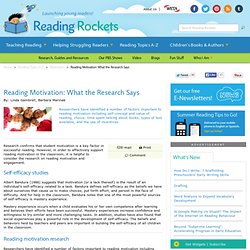
Bandura, A. (1986). Social foundations of thought and action: A social cognitive theory. Englewood Cliffs, NJ: Prentice Hall. English Language Learners and the Five Essential Components of Reading Instruction. Click the "References" link above to hide these references.
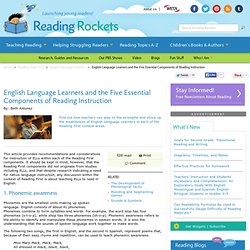
August, D., Hakuta, K. (1997). Improving schooling for language-minority children: A research agenda. Washington, DC: National Research Council. Center for the Improvement of Early Reading Achievement. (2001). Differentiated Instruction: English Language Learners. English language learners (ELLs) face major academic challenges as they work to acquire conversational language skills, as well as the more formal academic language they need to learn content in English.

When teaching ELL students, it is important to remember that just like native speakers, ELL students bring a wealth of background experiences into your classroom and have a range of learning style preferences and cultural backgrounds, all of which should be considered when planning their reading instruction. Who Are ELL Students? English language learners: Are trying to acquire English language proficiency, while in English-speaking classrooms. Klemek. ESL Apps - iPad in the ESL classroom. Essentials for Effective Reading Instruction. By Carolyn A.
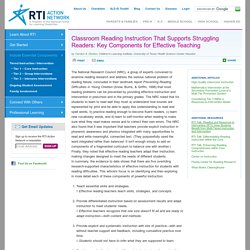
Denton, Children's Learning Institute, University of Texas Health Science Center Houston The National Research Council (NRC), a group of experts convened to examine reading research and address the serious national problem of reading failure, concluded in their landmark report Preventing Reading Difficulties in Young Children (Snow, Burns, & Griffin, 1998) that most reading problems can be prevented by providing effective instruction and intervention in preschool and in the primary grades. The NRC noted that for students to learn to read well they must a) understand how sounds are represented by print and be able to apply this understanding to read and spell words, b) practice reading enough to become fluent readers, c) learn new vocabulary words, and d) learn to self-monitor when reading to make sure what they read makes sense and to correct their own errors. Teach the Essentials.
Differentiated Instruction for Reading. What Is differentiated instruction?
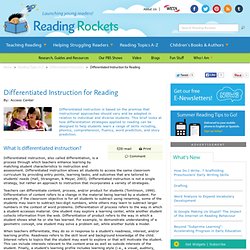
Differentiated instruction, also called differentiation, is a process through which teachers enhance learning by matching student characteristics to instruction and assessment. Differentiated instruction allows all students to access the same classroom curriculum by providing entry points, learning tasks, and outcomes that are tailored to students' needs (Hall, Strangman, & Meyer, 2003).
Differentiated instruction is not a single strategy, but rather an approach to instruction that incorporates a variety of strategies. Teachers can differentiate content, process, and/or product for students (Tomlinson, 1999). Differentiation of content refers to a change in the material being learned by a student. Differentiated Instruction: Reluctant and Striving Readers. Storia will engage the reluctant and struggling readers in your classroom.
These readers have diverse learning needs, and there is no “one size fits all” strategy for working with them. Storia - iPad App for Kids. Discover the innovative features designed to capture your child's imagination. Storia will help you support a growing love for reading at home and in the classroom. Download our free iPad app for kids and gain access to thousands of highly curated Scholastci eBooks for all ages and reading levels. From favorite picture eBooks to the hottest new series, Storia has the titles kids want, in a digital book format they love. Classroom Strategies. Paragraph Hamburger. Writing Activities and Strategies for ELLs. RAFT. From Jim Wright: Intervention Ideas for WRITING. The act of writing contains its own inner tensions. Writers must abide by a host of rules that govern the mechanics and conventions of writing yet are also expected—within the constraints of those rules-- to formulate original, even creative, thoughts.
It is no wonder that many students find writing to be a baffling exercise and have little sense of how to break larger writing assignments into predictable, achievable subtasks. But of course writing can be taught and writing can be mastered. The best writing instruction places the process of written expression on a timeline: Good writers first plan their writing. Then they write. Content: Memorize a Story Grammar Checklist (Reid & Lienemann, 2006). References Bos, C.S. & Vaughn, S. (2002). 25 Ways to Motivate Young Writers. Page 1 of 2 Inspiring students is the key to improving their writing skills.
Writing with a purpose is the primary motivator in producing high quality work. Authentic writing activities encourage students to focus on their strengths and areas of interest while simultaneously working to improve their weaknesses. "Why do we have to do this? " It's the question you dread to hear, but teachers who hear it are given a golden opportunity for a teaching moment. There are many purposes of writing: Get a driver's license Fill out a job application Create a resume Express feelings Organize thoughts Pass a class Get into college Earn a living. Ten Ideas That Get Kids Writing. By: NWP Staff Publication: www.nwp.org Date: May 2003 Summary: All teachers confront the challenge of motivating their students to want to write. While the NWP does not believe there is any single "correct" way to teach writing, here are 10 ideas that NWP teachers have found successful. 1.
MotivatingStudentstoReadandWriteinAllDisciplines. Using Music to Improve Reading Fluency. Using Smart Recorder to improve Reading Fluency. Research shows that when students integrate recordings of their reading into their fluency practice, their success rate increases. By guiding our students to make recordings of themselves, listening to those recordings and then reflecting on them, we can make the time spent reading more productive in improving fluency.
Using the app called Smart Recorder on your iPad or iPod touch is great for this because it not only records the reader's voice, it also times them and displays the sound waves their voice creates to check for proper expression and pausing. Using this app gives both the student and teacher evidense of the three critical factors of fluent reading: speed, accuracy, and expression. Fluency Idol. Fluency Intervention. Motivating Boys to Read. READ 7262, lesson plan #1, for presentation uploading. READ 7262, lesson plan #2, for presentation uploading.